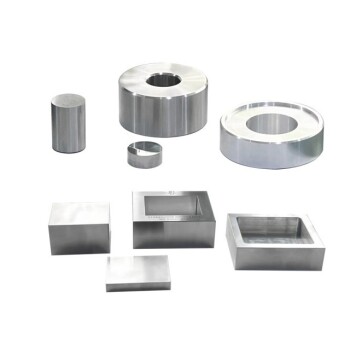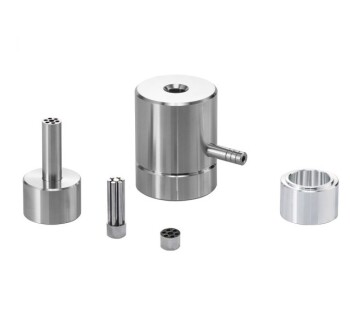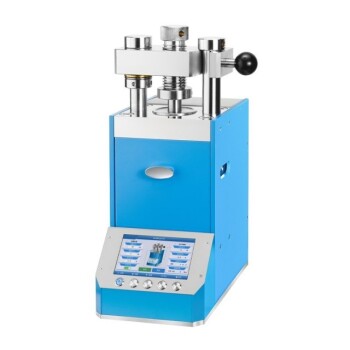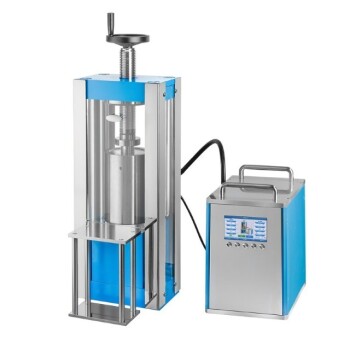Operating a vacuum hot press furnace is a task of precision, where success depends on more than just following a recipe. The key operational considerations involve three distinct areas: ensuring rigorous safety protocols, especially for systems like oil diffusion pumps; selecting the appropriate core hardware, such as heating elements and pressurization methods; and meticulously optimizing process parameters like temperature, pressure, and vacuum levels for the specific material being processed.
The successful operation of a vacuum hot press is not about maximizing individual parameters, but about orchestrating a delicate balance between heat, pressure, and vacuum. Each element must be precisely controlled to achieve full material densification without introducing defects or creating safety hazards.
The Core Principle: Sintering Under Controlled Force
To operate a furnace effectively, you must first understand the fundamental goal: creating a dense, strong, and pure final part from a powder or pre-formed material.
What is Vacuum Hot Pressing?
Vacuum hot pressing is a process that simultaneously applies high temperature and high pressure to a material inside a vacuum-sealed chamber. This combination of forces causes the individual particles of the material to bond and fuse together.
The goal is to eliminate the empty spaces (porosity) between particles, resulting in a dense, solid, polycrystalline structure with superior mechanical and physical properties.
The Critical Role of Vacuum
The vacuum environment is not just an afterthought; it is essential for material quality. Its primary purpose is to prevent oxidation and other chemical reactions that would occur if the material were heated to high temperatures in the presence of air.
A deep vacuum also helps remove gases that may be trapped within the starting powder, which, if left, would create voids and weaken the final product.
The Synergy of Heat and Pressure
Heat and pressure work together to achieve densification. The furnace heats the material, typically using graphite or induction elements, to a temperature where it softens and becomes more plastic.
Simultaneously, a hydraulic or mechanical system applies immense pressure (from 10 to over 1000 MPa). This force physically collapses the voids between the now-pliable particles, dramatically increasing the material's density and strength.
Mastering Key Operational Parameters
Achieving a successful outcome requires precise control over several interdependent variables. Each parameter must be tuned to the specific thermal and mechanical properties of the material you are working with.
Temperature Control and Uniformity
Temperature is arguably the most critical parameter. It must be high enough to allow for atomic diffusion and particle bonding but remain below the material's melting point.
Uniform heating across the entire part is crucial. Non-uniform temperatures create thermal gradients, leading to internal stresses that can cause warping or cracking either during the process or upon cooling.
Pressure Application and Magnitude
Pressure is the primary driver for densification. The amount of pressure required depends entirely on the material's resistance to deformation at the target temperature.
The method of application matters. Hydraulic systems generally offer more precise and uniform control over the applied force compared to purely mechanical systems, which is critical for sensitive or complex parts.
Vacuum Level and Integrity
The quality of your vacuum directly impacts the purity and integrity of your final material. A stable, deep vacuum ensures a clean processing environment.
Any leaks in the system can introduce contaminants like oxygen or nitrogen, leading to unwanted reactions and compromised material properties. Constant monitoring of the vacuum level is a key operational task.
Heating and Cooling Rates
The speed at which you heat and cool the material can be as important as the peak temperature itself. Rapid temperature changes can induce thermal shock, causing catastrophic failure in brittle materials like ceramics.
These rates must be carefully calculated and programmed based on the material's coefficient of thermal expansion and its ability to withstand internal stress.
Understanding the Trade-offs and Safety Risks
While vacuum hot pressing offers significant advantages, it comes with operational complexities and inherent risks that must be managed.
Safety: The Non-Negotiable Priority
These furnaces combine multiple hazards: extreme temperatures, high-pressure hydraulic or mechanical systems, high voltage, and potentially volatile vacuum equipment.
Oil diffusion pumps, in particular, require strict safety protocols. A sudden loss of vacuum or an air leak can expose hot oil to oxygen, creating a significant fire or explosion risk. Rigorous maintenance and operator training are not optional.
Process Efficiency vs. Material Quality
There is often a trade-off between the speed of the process and the ultimate quality of the part. Faster heating/cooling cycles and shorter hold times increase throughput but may result in lower density or higher internal stress.
Achieving maximum theoretical density and strength often requires slower, more deliberate cycles, which decreases production efficiency. The right balance depends entirely on the application's requirements.
Material and Geometry Limitations
While versatile, the process is not universal. The effectiveness of hot pressing is highly material-dependent. Some materials may react with the graphite tooling, requiring alternative, more expensive die materials.
Furthermore, the process is best suited for simple shapes (e.g., cylinders, blocks). Complex geometries are difficult to press uniformly, often leading to density gradients and weak points in the final part.
How to Apply This to Your Project
Your operational strategy should be dictated by your end goal. Use these guidelines to prioritize your efforts.
- If your primary focus is maximum density and strength: Concentrate on achieving slow, uniform heating and applying consistent, high pressure throughout the soak period.
- If your primary focus is high purity for sensitive applications: Prioritize achieving and maintaining the deepest possible vacuum level to prevent any contamination.
- If your primary focus is process efficiency and throughput: Carefully optimize your heating and cooling rates to be as fast as the material can safely tolerate without cracking.
- If your primary focus is operational safety: Implement and enforce a strict maintenance schedule for all systems, with a special focus on vacuum pumps and seal integrity.
By moving from simple operation to a deep understanding of these interconnected principles, you transform the vacuum hot press from a tool into a precision instrument for materials innovation.
Summary Table:
| Key Area | Considerations |
|---|---|
| Safety Protocols | Rigorous protocols for oil diffusion pumps, high temperatures, and pressure systems to prevent hazards. |
| Core Hardware | Selection of heating elements (e.g., graphite), pressurization methods (e.g., hydraulic systems), and vacuum pumps. |
| Process Parameters | Optimization of temperature, pressure, vacuum levels, and heating/cooling rates for specific materials. |
| Material and Geometry | Suitability for materials and simple shapes to avoid defects and ensure uniform densification. |
Unlock Precision in Your Laboratory with KINTEK's Advanced Lab Press Machines
Are you aiming to achieve superior material densification, enhance purity, or boost operational efficiency in your lab? KINTEK specializes in high-performance lab press machines, including automatic lab presses, isostatic presses, and heated lab presses, designed to meet the rigorous demands of vacuum hot pressing and other sintering processes. Our equipment ensures precise control over temperature, pressure, and vacuum levels, helping you avoid defects and safety risks while maximizing throughput and material quality.
Contact us today via our contact form to discuss how our tailored solutions can address your specific laboratory needs and drive innovation in your projects!
Visual Guide
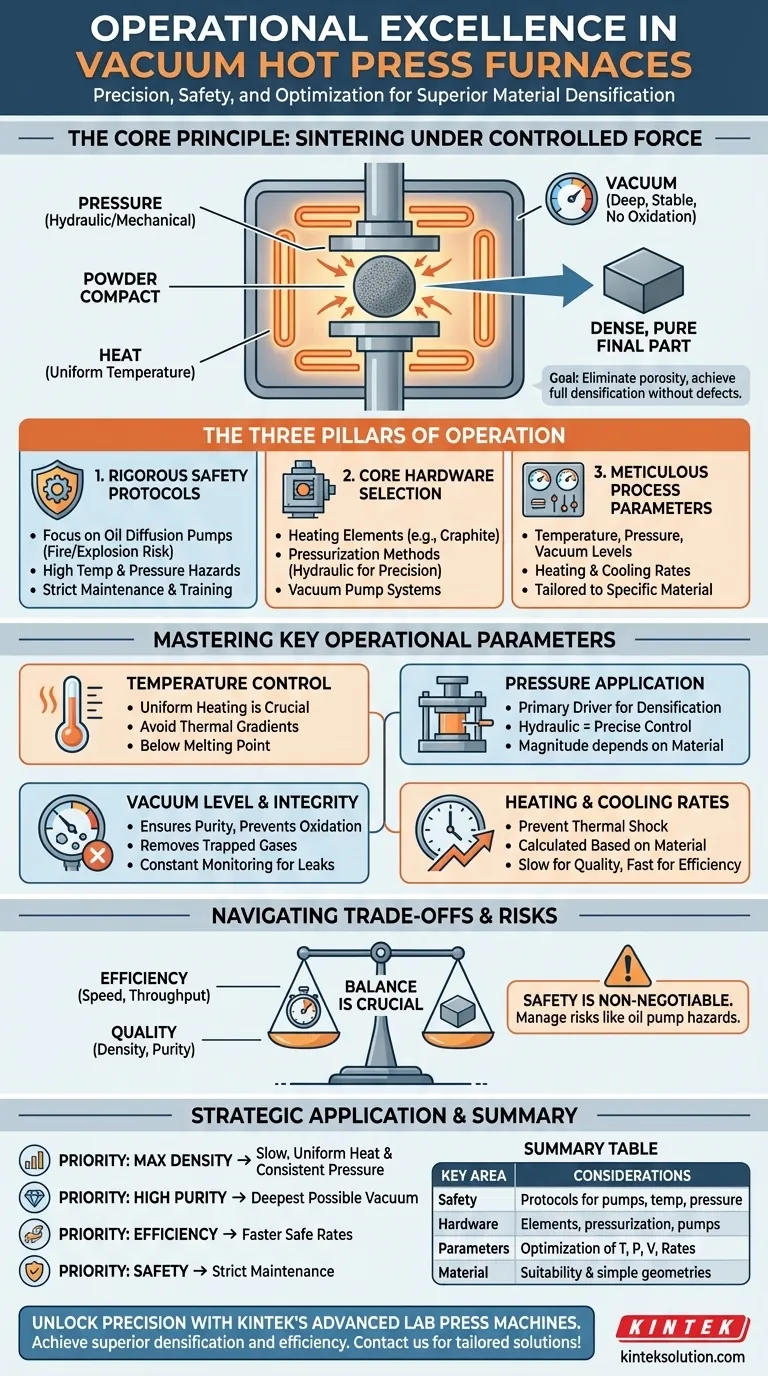
Related Products
- Heated Hydraulic Press Machine With Heated Plates For Vacuum Box Laboratory Hot Press
- Heated Hydraulic Press Machine with Heated Plates for Vacuum Box Laboratory Hot Press
- Automatic Heated Hydraulic Press Machine with Hot Plates for Laboratory
- Automatic High Temperature Heated Hydraulic Press Machine with Heated Plates for Lab
- Laboratory Manual Heated Hydraulic Press Machine with Hot Plates
People Also Ask
- What is a hydraulic hot press machine and how does it differ? Unlock Precision in Material Processing
- What role does a heated hydraulic press play in powder compaction? Achieve Precise Material Control for Labs
- What is the primary function of a hydraulic heat press? Achieve Precise Bonding and Shaping with Controlled Force and Heat
- How is a hydraulic heat press used in laboratory sample preparation? Create Uniform Samples for Accurate Analysis
- What industrial applications does a heated hydraulic press have beyond laboratories? Powering Manufacturing from Aerospace to Consumer Goods













